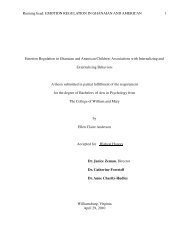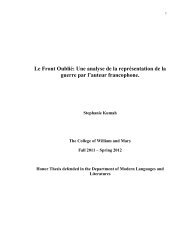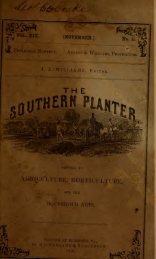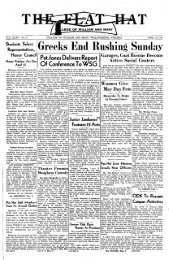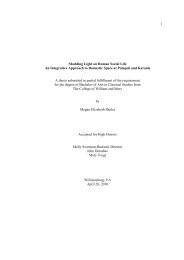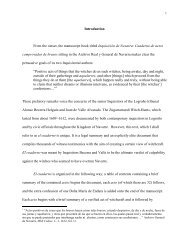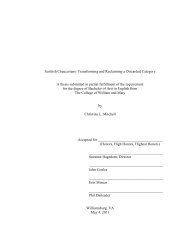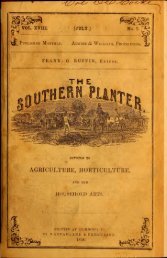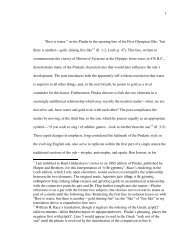Southern planter - The W&M Digital Archive
Southern planter - The W&M Digital Archive
Southern planter - The W&M Digital Archive
Create successful ePaper yourself
Turn your PDF publications into a flip-book with our unique Google optimized e-Paper software.
1908.]<br />
WORK FOR THE MONTH.<br />
In our review of the results of the year's work on<br />
<strong>Southern</strong> farms in the December issue, we were unable<br />
THE SOUTHERN PLANTER.<br />
Farm Management.<br />
to give more than an estimate of the yield of the cotton<br />
crop. We stated our belief that the crop would be<br />
materially less than that of the previous year. We are<br />
now in receipt of the official estimate of the crop, which<br />
Is placed by the Department of Agriculture at 11,678,000<br />
bales. This is as we estimated, a large reduction in the<br />
yield in- the previous year, which was estimated at<br />
12,500,000 bales. <strong>The</strong> crop this year was grown on about<br />
32,000,000 acres, which makes the average yield about one-<br />
third of a bale to the acre. Even though cotton sold at<br />
a much higher price than it is now selling at, or than<br />
it sold at at any time last year, such a yield as this makes<br />
but a miserable poor return for the labor expended with-<br />
out allowing anything for the fertilizer. In no other<br />
branch of <strong>Southern</strong> agriculture is there more need for a<br />
radical change in methods than in cotton production. It<br />
has been demonstrated in hundreds of cases that a bale<br />
to the acre can be easily made on land of average fertil-<br />
ity properly prepared and worked and more than twice this<br />
yield can be produced on rich land. <strong>The</strong> production of a<br />
bale to the acre would mean at present prices a fair re-<br />
turn for the labor and fertilizer needed to produce the<br />
crop and would set at liberty over 20,000,000 acres of land<br />
upon which to produce other crops which we now buy<br />
in the markets of the world. <strong>The</strong> same or very little more<br />
labor would make the cotton crop of one bale to the acre<br />
which is now expended in making a third of a bale and<br />
the time saved in preparing and planting 20,000,000 acres<br />
in cotton could be used to produce corn, wheat, oats, hay<br />
and the leguminous crops on which to raise and feed cat-<br />
tle, sheep and hogs, the market for which products is always<br />
a good one and which, in ithe South, is at present<br />
supplied by the farmers of the North and West. <strong>The</strong> pro-<br />
duction of live stock would mean the improvement of the<br />
fertility of the land and therewith the capacity to make a<br />
heavy cotton crop on the reduced area at less cost for fertilizer.<br />
Thus while materially reducing land to be worked<br />
and thus saving money on the labor bill as large a cotton<br />
crop would be made, and this at much greater profit. Whilst<br />
there has already been a gratifying increase in ithe in-<br />
terest shown in live stock husbandry in the South yet<br />
there is room for an enormous increase in the production<br />
of meat in the South. We yet keep our meat-house sadly<br />
too ofiten in the West and let the Western farmer make<br />
the profit on its production. We can make this meat at<br />
home cheaper than the Western man can make it and yet<br />
make a larger profit in doing so than he can, and can at<br />
the same itime keep our money at home for improving our<br />
farms and homes.<br />
<strong>The</strong> report on the area seeded to wheat during the<br />
fall months and its condition in December has just<br />
reached us. From this we find that there has been a re-<br />
duction in the area sown as compared with last year of<br />
about 1 per cent.—equivalent to- a decrease of 596,000<br />
t<br />
acres. <strong>The</strong> total acreage sown is 31,069,000. Maryland<br />
has sown 772,747 acres as against 796,646 acres sown last<br />
year. Virginia has sown 668,044 acres as against 674,792<br />
sown last year. North Carolina has sown 583,251 acres as<br />
against a similar area last year. South Carolina has<br />
sown 328,128 acres as against a similar area last year.<br />
Tennessee has sown 840,430 acres as against 823,951 acres<br />
sown last year. Tennessee is therefore the only one of<br />
these <strong>Southern</strong> States showing an increased area seeded.<br />
West Virginia and Kentucky also show less area seeded.<br />
This decreased seeding is much to be regretted as we<br />
need to produce much more wheat in the South rather<br />
than less. We do not make our own bread in any of the<br />
<strong>Southern</strong> States and this is a serious reproach to us, as<br />
there is no reason whatever why we should not only do<br />
this but also make wheat for export. Probably the decrease<br />
in the area seeded this year is largely to be accounted for<br />
by reason of the late maturing of our summer crops<br />
owing to the cold spring and early summer. Farmers were<br />
too busy saving what had been made to get the land in<br />
order for wheat seeding. <strong>The</strong> condition of the seeded<br />
crop throughout 'the country is not at all satisfactory, as<br />
is stands only at 91 as against 94 a year ago and a tenyear<br />
average of 93. This decrease in the area sown and<br />
the low condition taken together would indicate that this<br />
year's winter wheat crop is not likely to be an average<br />
one. <strong>The</strong> failure of the wheat crop to increase in area<br />
which has now been a characteristic for several years<br />
when taken in conjunction with our enormous annual in-<br />
crease in population would seem to indicate that the days<br />
of this country as the great wheat exporting nation of the<br />
world are numbered and that very shortly we shall become<br />
dependent on some other nation for part of our daily<br />
bread. Either the profitable wheat lands are exhausted or<br />
the cost of production has so increased on the old lands<br />
as to make it a non-profitable crop at the average level<br />
of prices fixed by the world's production. Canada and<br />
the Argentine are now forging to the front as the great<br />
wheat-producing countries of this continent. <strong>The</strong>y have<br />
both almost illimitable lands suited for the production of<br />
the crop and neither country has population to consume<br />
anything like even their present production. Argentina is<br />
now harvesting a magnificent crop of wheat which will<br />
all or nearly all be available for export. In the face of<br />
this we do not expect to see wheat advance much in<br />
value. Europe secured a very large share of our reserves<br />
from the crop of 1906 early in the fall of 1907 and can<br />
afford to wait for the the Argentine, Indian and Australian<br />
crops. Notwithstanding this outlook, we are of opinion<br />
that we ought to grow more wheat in the South. It is<br />
a crop for which a market can be found right at home<br />
at a price which will pay the cost of production when the<br />
land is properly prepared for it and it has the great advantage<br />
of being a crop which can be put into the ground<br />
at a time when work does not heavily press on the farmer<br />
and it comes off here in the South in ample time to be<br />
followed by another crop to be harvested the same year.<br />
This crop should be a leguminous one and then the land




